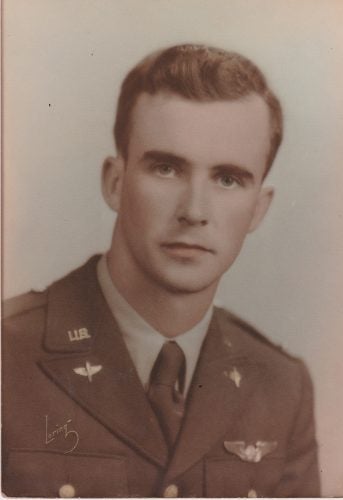- First Lieutenant
- WW II & Korea
Biography
James Bain Gorral, Jr. was born on 19 July 1925 and grew up in Pawtucket, Rhode Island. He was the son of James and Olive James. He graduated from Pawtucket High School where he was an outstanding student and participated in many school activities. James entered Rhode Island State College (RISC) in September 1945 with the class of 1949 majoring in Mechanical Engineering. He was a member of Alpha Tau Gamma fraternity and participated in the Army ROTC program. James left RISC after his freshman year and enlisted in the U.S. Air Force. Private James Bain Gorral Jr. attended the Army Air Force Indoctrination Program at the University of Vermont. The 61st College Training Detachment, which consisted of about 600 men, provided 37 hours of classroom instruction and 10 hours of flight training.
His next assignment was to the ten-week U.S. Air Force Navigator/Bombardier Training Program, Nashville, TN. Upon completion of Navigator/Bombardier School, he was awarded his wings, commissioned a Flight Officer and assigned to the 8th Army Air Forces, England. FO Gorral flew his first combat mission on February 14, 1945, flying as the Navigator/Bombardier in a B-17 flying fortress, dropping bombs on enemy targets near Dresden, Germany. The attack was aimed at disrupting Nazi communication centers in the path of Russian assault armor. By February 25, Flight Officer Gorral had flown 7 combat missions.
When the Korean War broke out in June 1950, Lt. Gorral volunteered for active duty. Assigned to the 3rd Bomber Wing, South Korea, he participated in the first bombing sortie to support the rapidly retreating South Koreans. His unit struck North Korean ground forces, destroying several enemy tanks and vehicles. President Truman authorized the Air Force to strike targets in North Korea and, in another first, the 3rd Bomber Wing launched sixteen B-26 Invaders against Pyongyang Airfield, destroying twenty-five North Korean aircraft on the ground and damaging another twenty.
The 3rd Wing moved to Kunsan Air Base, South Korea in August 1951 and had searchlights mounted on the B-26s. The new illumination proved highly effective over the flares that had been previously used. During the first mission with the searchlights, the wing’s B-26 crews succeeded in destroying an entire enemy freight train. The wing continued to fly low level attacks against the attacking North Korean columns. The North Koreans had been forced to stay off the roads during daylight hours. The wing switched to night missions, flying its jet-black B-26s against the North Korean columns.
On the night of 19 April 1952, 1Lt. James B. Gorral was preparing for takeoff of his B-26C Invader (Tail # 44-34098) as he and his crew had done many times with the mission of night interdiction attacks on Communist railroads and roads in North Korea. Shortly after taking off on Runway 24, the black B-26 aircraft, heavily loaded for combat, crashed and was swallowed up in the Yellow Sea one mile from shore with the entire crew killed in action. First Lieutenant James Bain Gorral Jr. was cited for Gallantry in Action and was posthumously awarded the Air Medal and Purple Heart.
1LT Gorral’s remains were recovered; and they were returned to Pawtucket, Rhode Island for burial with full military honors. First Lieutenant James Bain Gorral Jr. was a son of Rhode Island State College and a hero who answered the call to duty and gave his life during the Korean War.
Education
1949

